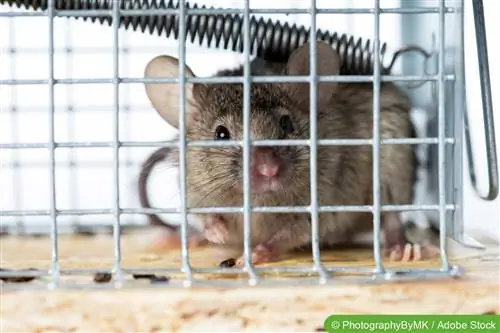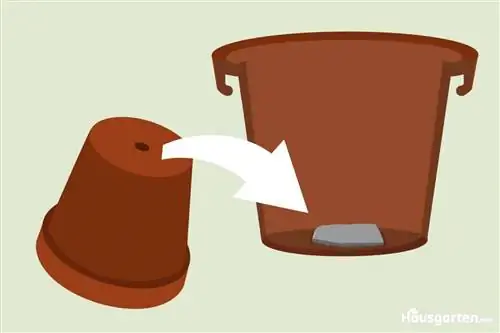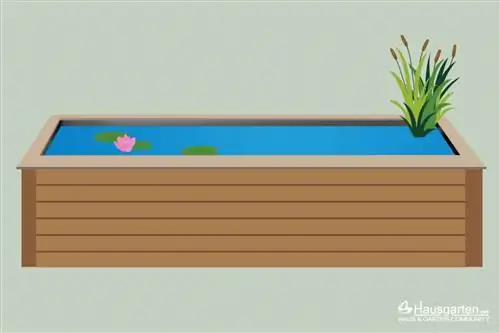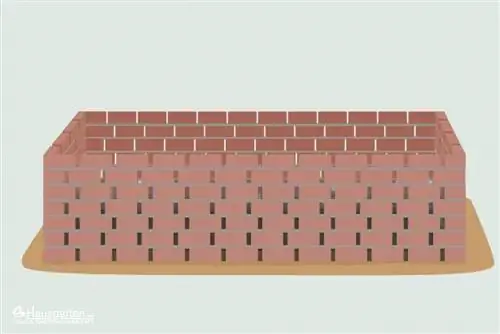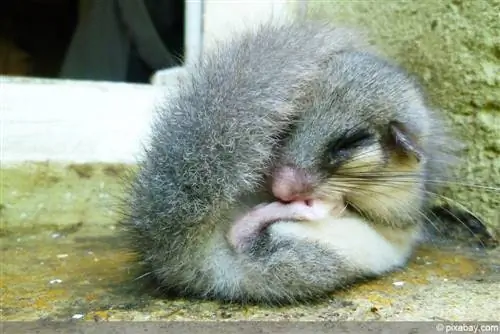- Author admin [email protected].
- Public 2023-12-17 03:39.
- Last modified 2025-01-24 12:45.
Nobody likes having mice in their apartment or garden. The easiest way to get rid of the mouse would be to get a cat. But not everyone wants that, and above all it can be very unpleasant for the poor mouse.
A mousetrap is quicker, and above all the mouse has a chance of survival. However, this only applies to a live trap that you can easily build yourself. Few things needed:
- A tall vessel such as a glass or a flower pot
- Two wooden slats
- Adhesive tape
- Bait, such as cheese, sausage or similar
The container is placed with the opening upwards in the place where the mouse was seen. Of course, the mouse cannot run up a glass or flower pot, so a path should be built up using the two wooden slats. It is best that the path is not too steep; this can be avoided if the wooden slats are set up in an L-shape. Then fix this with the adhesive tape. Then put the bait in the tall container, because without it the mouse will definitely not go up.
The mouse is stuck
After the mouse has caught the scent, it will follow the path to the end. This then falls into the vessel and can no longer run along the smooth wall. So this festival sits and can then be put outside again. But it's even easier, depending on where the mouse is. Because it is important that the mouse trap is placed where the mouse is. Otherwise, a purchased trap is of no use because it also has to smell the delicious food. Above all, mice don't love cheese as expected, but rather they are addicted to chocolate. The mice become addicted and all caution is forgotten when they only get their hands on the delicious chocolate.
A bucket and a wooden stick are also enough
The bucket should be placed in such a way that it is in an elevated place, such as on a staircase. The wooden stick should not be too long and, above all, not too heavy. The stick is then placed on the bucket so that it is approximately in the middle. The other end must not be too long so that the stick does not fall into the bucket. Now just put some tasty food, like chocolate, in the bucket. The mouse will then run up the stick, always smelling the delicious smell in its nose. When it reaches the other end of the stick, it gives way and the mouse has its chocolate. But she no longer has her freedom for the time being. This means that the mouse can be released outside again and the apartment is free of mice again. Especially if there is more than just one mouse involved, the chocolate can also be melted. Then take a lid off a drink and pour in the liquid chocolate. This means that a mouse can't empty the trap because it can't easily get to the bait.
A tall vessel is always important
What the trap should look like is up to each individual, but it has to be a tall and smooth vessel. Of course, it is also important that the mouse has a path, otherwise the mouse cannot get to the opening. Everyone has most of the things in their household and doesn't have to go to a hardware store. This means that home-made mouse traps are also inexpensive and, if set up correctly, are also escape-proof. It is therefore important that the path is built in such a way that it does not accidentally fall into the trap. Of course the mouse will then free itself and, if possible, eat the bait. Even if a mouse falls into a deep bucket, it will not be injured. This is precisely what is important to many people. The mouse simply shouldn't live in the sublet, because of course it isn't housebroken and nibbles on everything.
It could be even easier
To build a very simple and quick mouse trap, you only need two things. A small box, for example a shoe box and a pretzel stick. The box is turned over and the pretzel stick is used to make the box stand at an angle. When the mouse nibbles on the pretzel stick that is inside the box, the pretzel stick falls over. The mouse is now stuck under the box. Of course, the box must then be carefully closed so that the trapped mouse can no longer escape. Another type is again a box, a string, a thin pen and some tape. The string is tied tightly around the pen with one end. Then the cord is cut so that it is stuck with adhesive tape a few centimeters above the open edge. The box is placed with the opening at the bottom. Place the string as precisely as possible in the middle, slightly elevated. Place the pen under the edge of the box so that it stands open at an angle.
Place the food under the cord
In order for the trap to snap shut, the bait must be placed under the line. If the mouse comes and wants to get the food, it moves the string and the pen falls over. Of course, the mouse lives here too and can be released again later. Even if these animals were caught, they are absolutely not suitable as pets. So always put the trapped mouse outside, otherwise it will die in captivity.
What you should know about mousetraps in brief
Mice, like rats, are carriers of diseases, which is a good reason to combat rodent pests efficiently. Mouse traps come in different designs. If you don't want to touch the dead animals, it's better to use so-called live traps:
- These are small, sturdy cages, with a fixable flap at one end.
- This end is equipped with a special hook where you can attach bait material.
Since mice are actually not picky, there are hardly any limits to your imagination: from grapes to bread to sweets, you can attach pretty much anything here. Not only are the mice constantly hungry, they are also curious, so sooner or later they will try to get their hands on the food. To do this, however, they have to enter the cage.
- As soon as they start tugging on the bait, the trap closes and the mouse sits in the cage.
- The caught mice can then be taken outside and released outside, perhaps not right in front of the front door.
- It almost seems like a very personal invitation. This method of catching mice is certainly the gentler method, although not really the most effective.
The other type of mousetrap is the most common folding trap, where the mice are usually found dead. This is the more brutal method, but absolutely effective, as a dead mouse cannot come back nor produce offspring. Whether you use poison bait or mouse traps, you should always make sure that they are placed or set up out of the reach of children and pets. Poisoning and/or risk of injury!

